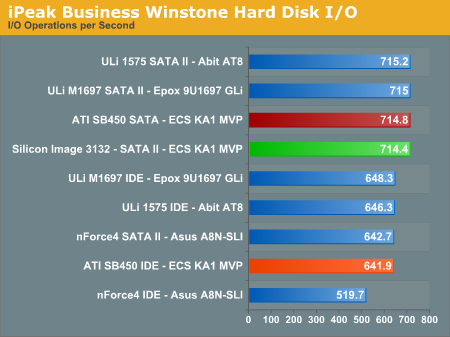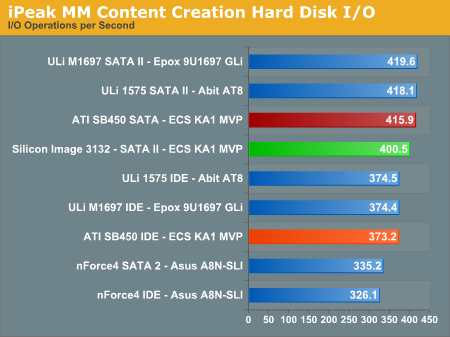Disk Controller Performance
With the variety of disk drive benchmarks available, we needed a means of comparing the true performance of the wide selection of controllers. The logical choice was Anand's storage benchmark first described in Q2 2004 Desktop Hard Drive Comparison: WD Raptor vs. the World. The iPeak test was designed to measure "pure" hard disk performance, and in this case, we kept the hard drive as consistent as possible while varying the hard drive controller. The idea is to measure the performance of a hard drive controller with a consistent hard drive.
We played back Anand's raw files that recorded I/O operations when running a real world benchmark - the entire Winstone 2004 suite. Intel's iPEAK utility was then used to play back the trace file of all IO operations that took place during a single run of Business Winstone 2004 and MCC Winstone 2004. To try to isolate performance differences to the controllers that we were testing, we used the Maxtor MaXLine III 7L300S0 300GB 7200 RPM SATA drive in all tests. The drive was formatted before each test run and a composite average of 5 tests on each controller interface was tabulated in order to ensure consistency in the benchmark.
iPeak gives a mean service time in milliseconds; in other words, the average time that each drive took to fulfill each IO operation. In order to make the data more understandable, we report the scores as an average number of IO operations per second so that higher scores translate into better performance. This number is meaningless as far as hard disk performance is concerned, as it is just the number of IO operations completed in a second. However, the scores are useful for comparing "pure" performance of the storage controllers in this case.


The performance patterns hold steady across both Multimedia Content IO and Business IO, with the ULi, ATI, and Silicon Image based disk controllers providing the fastest IO operations followed by the on-board NVIDIA nForce4 SATA controllers. The performance generated by the ULi and ATI IDE controller logic is particularly excellent, while the SATA performance of both is up to 12% better when compared to the nForce4 chipset. The SATA performance of the Silicon Image 3132 is very competitive with the core logic chipsets in our tests.
With the variety of disk drive benchmarks available, we needed a means of comparing the true performance of the wide selection of controllers. The logical choice was Anand's storage benchmark first described in Q2 2004 Desktop Hard Drive Comparison: WD Raptor vs. the World. The iPeak test was designed to measure "pure" hard disk performance, and in this case, we kept the hard drive as consistent as possible while varying the hard drive controller. The idea is to measure the performance of a hard drive controller with a consistent hard drive.
We played back Anand's raw files that recorded I/O operations when running a real world benchmark - the entire Winstone 2004 suite. Intel's iPEAK utility was then used to play back the trace file of all IO operations that took place during a single run of Business Winstone 2004 and MCC Winstone 2004. To try to isolate performance differences to the controllers that we were testing, we used the Maxtor MaXLine III 7L300S0 300GB 7200 RPM SATA drive in all tests. The drive was formatted before each test run and a composite average of 5 tests on each controller interface was tabulated in order to ensure consistency in the benchmark.
iPeak gives a mean service time in milliseconds; in other words, the average time that each drive took to fulfill each IO operation. In order to make the data more understandable, we report the scores as an average number of IO operations per second so that higher scores translate into better performance. This number is meaningless as far as hard disk performance is concerned, as it is just the number of IO operations completed in a second. However, the scores are useful for comparing "pure" performance of the storage controllers in this case.


The performance patterns hold steady across both Multimedia Content IO and Business IO, with the ULi, ATI, and Silicon Image based disk controllers providing the fastest IO operations followed by the on-board NVIDIA nForce4 SATA controllers. The performance generated by the ULi and ATI IDE controller logic is particularly excellent, while the SATA performance of both is up to 12% better when compared to the nForce4 chipset. The SATA performance of the Silicon Image 3132 is very competitive with the core logic chipsets in our tests.










23 Comments
View All Comments
Per Hansson - Saturday, April 8, 2006 - link
Well, from your last mobo review: "Attention - Per Hansson by Gary Key on: Mar 23, 2006 12:06 AMRating: 4Our next article will have a high resolution picture of the capacitors and other items of importance in a pop-up window. I am sure the capacitors utilized on this board will be of interest to you. ;->"
Gary Key - Saturday, April 8, 2006 - link
Please email me - I have the photographs. We are doing some revisions on the engine and could not get these in but I did take the photographs for you.
Stas - Wednesday, April 5, 2006 - link
I always had nVidia and ViA chjpset based mobos. Now I really want an ATi based mobo. Very nice perfromance and overclockablility. It's good that ECS made a board like that, better for the competition. I got tired of seeing 1337 ASUS and DFI mobos, now it's time for less popular companies.SilverTrine - Tuesday, April 4, 2006 - link
And somehow Nvidia gets a pass for all their issues. The original Nforce was a totally unstable board on par with something like Abits awful KG7. Yet the fanboism let many to the slaughter with that board. Nforce 2 also had severe USB and IDE problems, yet fanboism kept most of that in the dark.Hopefully we can all get past the fanboism and be honest about things, as long as people are getting paid to post on boards that is a pipe dream though. We simply have to call these vultures on their conduct.
QueBert - Tuesday, April 4, 2006 - link
I owned a number of Nf2 MB's, and now a Nf3. SW-IDE doesn't work at all on any of them for me. Infact on 1, it actually caused my burner to not burn until I uninstalled them. Nf3 I have the lovely NF Firewall thing, does this work even somewhat for anyone? I'm not a fan boy, but from my past Nvidia experince (and remember I run a NF3 board now...) the ATI couldn't possibly be much worse. could this board be bad? sure, you can take a decent chipset and ruin it with a poorly designed motherboard.bob661 - Tuesday, April 4, 2006 - link
I'm going to test the firewall sometime when I get the chance. I'm willing to bet I won't have problems but I could be wrong.Regs - Tuesday, April 4, 2006 - link
Examples of the peripherals that are suffering? Any one else want to fill me in?
Gary Key - Tuesday, April 4, 2006 - link
The Firewire and Marvel Gigabit Ethernet controller are tied to the SB450. The performance of these items are sub-par compared to results on other boards. This is explained in the test detail sections and the final words recap. We have a new bios today that should bring the performance of both peripherals up to par with other boards that utilize this same components. However, there is nothing that can be done with the USB 2.0 performance although it really is not that bad. :)JakeBlade - Tuesday, April 4, 2006 - link
I find it amazing that this website can test a motherboard more thoroughly than the company who makes it. Pathetic.highlnder69 - Tuesday, April 4, 2006 - link
You might want to fix the word mothergoard in the title to be motherboard..